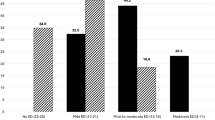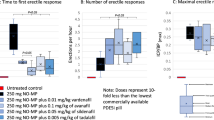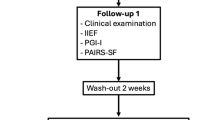Abstract
Study design:
Open, before–after study.
Objective:
To assess the efficacy and safety of phosphodiesterase type 5 (PDE5) inhibitors for erectile dysfunction (ED) in spinal cord-injured (SCI) patients.
Setting:
Home- and clinic-based assessments in the outpatient department at the Centre Bouffard Vercelli, Cerbère France.
Methods:
Clinic trials with Sildenafil (Viagra®) on 120 patients, Tadalafil (Cialis®) on 54 patients and Vardenafil (Levitra®) on 66 patients were performed. Flexible doses of PDE5 inhibitors were given depending on efficacy and tolerability, from 50 to 100 mg for Sildenafil, and from 10 to 20 mg for Vardenafil and Tadalafil. Each trial was performed after a week's interval. The efficacy was self-assessed by the patients on a six-point quantitative scale assessment. The response to treatment was assessed at home in 90 patients (57 patients on Sildenafil, 12 patients on Vardenafil and 21 patients on Tadalafil) using the International Index of Erectile Function (IIEF).
Results:
In clinic trials, PDE5 inhibitors were effective (rigidity enough for penetration) in 85% of the patients on Sildenafil, 74% of the patients on Vardenafil and 72% of the patients on Tadalafil. The mean duration of erection was 34, 28 and 26 min, respectively. Adverse effects were mild, usually attenuated with continued dosing. More than 70% of the patients on Vardenafil and Tadalafil required higher doses of 20 mg, whereas 50 mg of Sildenafil was effective in 55% of the patients. Two-thirds of our patients on Tadalafil reported a duration of action longer than 24 h. The presence of an upper motor neuron lesion was significantly associated with therapeutic success, lower motor neuron lesions and cauda equina patients were poor responders. Other variables such as completeness of lesion had no impact.
In the follow-up visits, the IIEF global scores and three IIEF domains (erectile function, intercourse satisfaction and overall satisfaction) were significantly improved in all patients. Patients on Sildenafil showed a significant improvement of orgasmic function, ejaculation (Question 9) and orgasm (Question 10).
Conclusion:
Sildenafil, Vardenafil and Tadalafil are all effective and well-tolerated treatments for ED in SCI patients. Although no statistical analysis could be applied on these data, these results might indicate that Sildenafil is more effective in treating ED. Clinic trials are important for proper dose titration and appropriate education of the patients.
Similar content being viewed by others
Log in or create a free account to read this content
Gain free access to this article, as well as selected content from this journal and more on nature.com
or
References
Derry F, Hultling C, Seftel AD, Sipski ML . Efficacy and safety of sildenafil citrate (Viagra) in men with erectile dysfunction and spinal cord injury: a review. Urology 2002; 60: 49–57.
Griffith ER, Tomko MA, Timms RJ . Sexual function in spinal cord-injured patients: a review. Arch Phys Med Rehabil 1973; 54: 539–543.
Biering-Sorensen F, Sonksen J . Sexual function in spinal cord lesioned men. Spinal Cord 2001; 39: 455–470.
Bors E, Comarr E . Neurological disturbances of sexual function with special reference to 529 patients with spinal cord injuries. Urol Surv 1960; 10: 191–222.
Comarr AE, Vigue M . Sexual counseling among male and female patients with spinal cord and/or cauda equina injury. Am J Phys Med 1978; 57: 107–122.
Lee LM, Stevenson RW, Szasz G . Prostaglandin E1 versus phentolamine/papaverine for the treatment of erectile impotence: a double-blind comparison. J Urol 1989; 141: 549–550.
Virag R, Sussman H, Floresco J . Late results on the treatment of neurogenic impotence by self-intracavernous-injection (SICI) of vasocactive drugs. World J Urol 1987; 5: 166–170.
Schmid DM, Schurch B, Hauri D . Sildenafil in the treatment of sexual dysfunction in spinal cord-injured male patients. Eur Urol 2000; 38: 184–193.
Hultling C, Giuliano F, Quirk F, Pena B, Mishra A, Smith MD . Quality of life in patients with spinal cord injury receiving Viagra (sildenafil citrate) for the treatment of erectile dysfunction. Spinal Cord 2000; 38: 363–370.
Maytom MC et al. A two-part pilot study of sildenafil (VIAGRA) in men with erectile dysfunction caused by spinal cord injury. Spinal Cord 1999; 37: 110–116.
Giuliano F et al. Randomized trial of sildenafil for the treatment of erectile dysfunction in spinal cord injury. Sildenafil Study Group. Ann Neurol 1999; 46: 15–21.
Del Popolo G, Li Marzi V, Mondaini N, Lombardi G . Time/duration effectiveness of sildenafil versus tadalafil in the treatment of erectile dysfunction in male spinal cord-injured patients. Spinal Cord 2004; 42: 643–648.
Rosen RC, Riley A, Wagner G, Osterloh IH, Kirkpatrick J, Mishra A . The International Index of Erectile Function (IIEF): a multidimensional scale for assessment of erectile dysfunction. Urology 1997; 49: 822–830.
Dinsmore WW, Mayton MC . Sildenafil (Viagra): a two stage, double-blind, placebo controlled study in men with erectile dysfunction (ED) caused by traumatic spinal cord injury (SCI). Int J Impot Res 1998; 10: S49.
Sanchez Ramos A et al. Efficacy, safety and predictive factors of therapeutic success with sildenafil for erectile dysfunction in patients with different spinal cord injuries. Spinal Cord 2001; 39: 637–643.
Hulting C et al. Effect of sildenafil (Viagra) on quality of life in men with erectile dysfunction caused by traumatic spinal cord injury. Int J Impot Res 1998; 10: S32 (Abst. 245).
Garcia-Bravo AM, Suarez-Hernandez D, Ruiz-Fernandez MA, Silva Gonzalez O, Barbara-Bataller E, Mendez Suarez JL . Determination of changes in blood pressure during administration of sildenafil (Viagra®) in patients with spinal cord injury and erectile dysfunction. Spinal Cord 2006; 44: 301–308.
Ethans KD, Casey AR, Schryvers OI, MacNeil BJ . The effects of sildenafil on the cardiovascular response in men with spinal cord injury at or above the sixth thoracic level. J Spinal Cord Med 2003; 26: 222–226.
Sonksen J, Biering-Sorensen F . Fertility in men with spinal cord or cauda equina lesions. Semin Neurol 1992; 12: 106–114.
Tarabulcy E . Sexual function in the normal and in paraplegia. Paraplegia 1972; 10: 201–208.
Mirone V et al. An evaluation of an alternative dosing regimen with tadalafil, 3 times/week, for men with erectile dysfunction: SURE study in 14 European countries. Eur Urol 2005; 47: 846–854; discussion 854.
Hatzichristou D et al. Sildenafil failures may be due to inadequate patient instructions and follow-up: a study on 100 non-responders. Eur Urol 2005; 47: 518–522; discussion 522–513.
Siosteen A, Lundqvist C, Blomstrand C, Sullivan L, Sullivan M . Sexual ability, activity, attitudes and satisfaction as part of adjustment in spinal cord-injured subjects. Paraplegia 1990; 28: 285–295.
Acknowledgements
We thank Dr B Sutter, MD, for his assistance in data analysis.
Author information
Authors and Affiliations
Rights and permissions
About this article
Cite this article
Soler, J., Previnaire, J., Denys, P. et al. Phosphodiesterase inhibitors in the treatment of erectile dysfunction in spinal cord-injured men. Spinal Cord 45, 169–173 (2007). https://doi.org/10.1038/sj.sc.3101950
Published:
Issue date:
DOI: https://doi.org/10.1038/sj.sc.3101950
Keywords
This article is cited by
-
Erectile Dysfunction and Neurological Comorbidities: a Contemporary Review
Current Sexual Health Reports (2020)
-
Positive sexuality in men with spinal cord injury
Spinal Cord (2018)
-
A randomized double-blind, placebo-controlled, cross-over trial assessing the effect of tadalafil (Cialis) on the cardiovascular response in men with complete spinal cord injury above the sixth thoracic level: A Pilot Study
Spinal Cord Series and Cases (2018)
-
Prediction of sexual function following spinal cord injury: a case series
Spinal Cord Series and Cases (2017)
-
Efficacy and safety of phosphodieterase-5 inhibitors for treatment of erectile dysfunction secondary to spinal cord injury: a systemic review and meta-analysis
Spinal Cord (2016)



